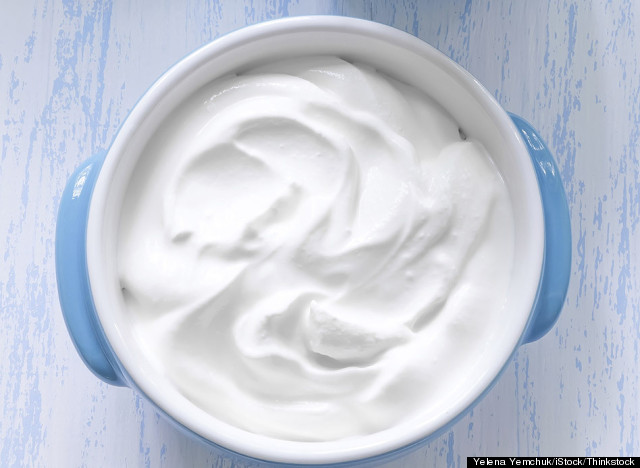
- Protein: Greek yogurt is high in protein which promotes a sustained sense of fullness. A typical 6-ounce serving contains 15 to 20 grams, the amount in 2 to 3 ounces of meat. A 6-ounce serving of regular yogurt provides just 9 grams, meaning you may feel hungry sooner. One cup (8 ounces) of plain, non-fat Stonyfield organic “Oikos” Greek yogurt provides 23 grams of protein. This makes Greek yogurt especially appealing to vegetarians, who tend to avoid many sources of animal protein.
- Carbohydrates: Greek yogurt contains about half the carbohydrates of regular yogurt, 5 to 8 grams compared with 13 to 17 per 6-ounce serving. One cup of plain, non-fat Stonyfield organic “Oikos” Greek yogurt provides 9 grams of carbohydrate. Since the straining process removes some of the lactose, Greek yogurt is less likely than regular yogurt to cause digestive problems in lactose-intolerant individuals. Note that both types of yogurt will contain higher amounts of carbohydrate if sweetened with sugar or other ingredients like honey, dextrose, fruit blends, etc. Try to select yogurt with less or no added any sugar.
- Fat: Avoid whole milk yogurt due to it’s high saturated animal fat content. Seven ounces of “Fage’s” full-fat Greek yogurt contains 16 grams of saturated fat, or 80% of your total daily allowance if you are on a 2000 calorie diet (that’s more than in 3 “Snickers” bars). Dannon’s regular full-fat yogurt contains 5 grams of saturated fat per 8-ounce serving. Saturated animal fat raises total cholesterol, as well as harmful low-density lipoprotein (LDL) cholesterol levels, thus increasing the risk of heart disease. Always read nutrition labels carefully, and choose low-fat or non-fat yogurt.
- Sodium: An 8-ounce serving of plain, non-fat Stonyfield organic “Oikos” Greek yogurt contains 95 milligrams of sodium, about half the amount in a similar serving size of most brands of American yogurt. Note that excess dietary sodium can elevate the risk of heart, kidney, and vascular problems. The federal government’s 2010 Dietary Guidelines for Americans recommend less than 2300 milligrams of sodium intake daily for healthy individuals, and less than 1500 milligrams daily for all African Americans, individuals over 50 years of age, and those with or at risk of high blood pressure (hypertension), diabetes, or chronic kidney disease.
- Calcium: American and Greek yogurts are both excellent sources of dietary calcium, each providing about 30% of the recommended daily calcium requirement per 8-ounce serving. To further increase your dietary intake of calcium, include more low-fat or non-fat milk, beans, nuts like almonds, seeds like sesame, and green leafy vegetables like bok choy, collards, dandelions, mustard greens, swiss chard, and turnips.
Remember to always read nutrition labels and check expiration dates. Live bacterial cultures in yogurt and kefir tend to diminish over time. Therefore, try to finish these products well before their expiration date. Be careful of flavored varieties of yogurt which may contain extra calories from corn syrup, fruit purees, modified food starch, sugar and other sweeteners, and less of yogurt’s natural health benefits.
Nutritious and easy to prepare, the following recipe can be served at breakfast or lunch, as a snack, or in place of rich desserts:
Ingredients:
- Nonfat Greek yogurt (“Chobani”, “Fage”, “Oikos”, or any other natural yogurt)
- Chopped, unsalted, and unflavored nuts and/or seeds, such as almonds, walnuts, pecans, peanuts, pumpkin, sesame, or sunflower seeds
- Chopped fresh fruit or berries (optional)
- Honey
Place yogurt in serving dish. Sprinkle chopped nuts, seeds, and fresh fruit, on top. Drizzle with honey. Enjoy!

Variations:
- Wheat germ or ground flax seeds may be substituted in place of other nuts and seeds.
- Chopped fresh fruit, berries, dates, figs, raisins, and/or granola cereal may be added for more fiber and nutrients.
- Fresh fruit, nuts, granola, and honey.
- Use Greek yogurt as a cream substitute in sauces or curries. It’s much lower in fat than cream but still provides the same creamy taste. Just turn the heat off, allow the dish to cool slightly before adding the yogurt (so it doesn’t curdle), and then stir it in.

Comments on this entry are closed.